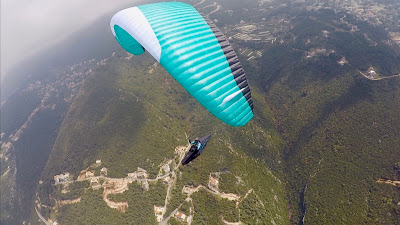DaVinci Tango
let’s dance…
DaVinci is a South Korean manufacturer with a complete set of gliders from the A to CCC category.
The Tango is their new EN-C glider and my first DaVinci glider!
After receiving emails from pilots worldwide, I contacted DaVinci and I was able to purchase the Tango in S size (70-95).
https://flydavinci.com/products/paragliders/tango/
To tell you the truth, I was a bit concerned at first about the new company, and I had silly thoughts in my rusty mind about what to expect…
Now the glider is in front of me and it is time to fly. The construction looks really good. The Tango has 3 lines A, B, C, and a little fork on the C’s. It is not a hybrid like the Fusion for example. I thought also that it could be similar to the Flow Fusion. But it isn’t in any way. It is a 3 liner. Let’s proceed…
The glider is a mixture of Dominico on the upper surface leading edge, which holds a shark nose, and Porcher 32 g behind, with also Porcher on the bottom surface. The lines are from Edelrid. Aramid lines are used all over the glider. All the lines are unsheathed, but also they seem carefully chosen as they are not as thin as the competition, nor they are thick. They seem to have a good balance for durability, and performance.
And I don’t think they will move quickly in time.
I flew the Tango at different loads, 89, 92, and later at 94 all up. The inflation of the Tango is as easy as a B glider. It rises quickly without any surge and the take-off is immediate even in nil wind. Looking up I saw a super clean leading edge and construction! I was really amazed by the details and the sewing process. They were no crisp seen on this super finish leading edge.
First turn and first satisfaction, at least from my part concerning handling. The brake could be described as short, linear, precise, delivering very good agility. The Tango can be steered very flat, and also could squeeze every lift very tight! That’s my cherry on the cake! The leading edge felt smooth in turbulence and I didn’t feel any pitch movements. The Tango enters smoothly even in rough air, with a slight pitch in turbulent air, but climbs really well upwind, and it seems that the internal structure is very homogenous.
It felt easy to fly for a 6.3 AR, C glider. A bit like the Delta 4 for accessibility! To make it more accurate, it seems very close to the Artik 5 I had, in terms of overall feel and handling.
Doing some glides next to the Cure 2 M loaded at 93 showed me very close gliding properties! I can also confirm that the Tango trim speed is high matching the Cure 2 M. At full bar, the Tango is really fast! Matching the loaded Cure 2 M. What impressed me the most, is that at high speed the leading edge remained clean and untouched without any weakness or crisp on the materials. It seems that their new SN+ (Smart nose plus technology) is working well! The SN+, is some kind of valve or tape on the leading edge, preventing the air from going out quickly while retaining the pressure in the nose.
Honestly, I was really surprised about those performances! To place the Tango in gliding efficiency, it would be inserted on the top 5 of the C category!
The best is yet to come…The climbing properties of the Tango next to the C’s that were present seem really rewarding especially in weak lift. The Tango is indeed a floater. I could feel a very high efficiency at 92 all up in very weak thermals. I can confirm that it climbs as good as the Cure 2 for example.
I like to point out more accurately, that surfing into the wind had better results when I loaded the Tango at 95 all up. I felt that when loaded it could move a bit better through the airmass in the presence of a headwind. If flown at 90 all up it felt very slow in entering that airmass. So it likes to be loaded when you need to go through. At max load, the climbing efficiency was still excellent.
Ears are stable, efficient, and reopens without pilot input.
Conclusion: My first encounter with DaVinci gliders seems well rewarded! The Tango is fast at trim and accelerated and likes to be loaded, with a very good package of climb and glide.
It is well comfortable for a 6.3 AR EN-C glider. Induced asymmetric with one A riser pulled, are soft, and super easy to stay on track with a fast reopening. The speed bar has moderate pressure and usable all the way.
My C comparison will be updated for little details.
One thing is sure! If you are looking for an EN-C, don’t miss to test fly the Tango!




























